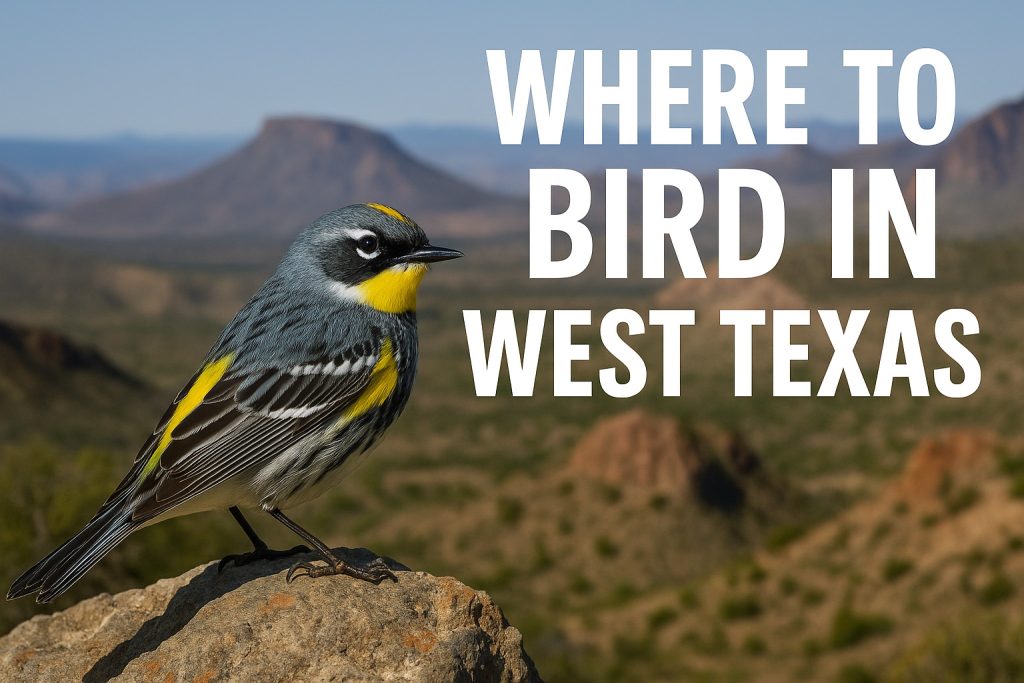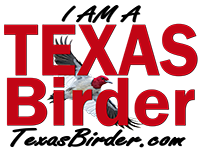
Before you grab your binocs and chase that next lifer, just a quick note: this list highlights some of the most popular birding locations in the region, with only the basics to get you started. Think of it as a beginner’s guide for your next birdy road trip. We’re working on adding even more locations, juicy details, seasonal tips, and probably a few “you had to be there” birder stories. And hey—if you’re out exploring Texas, keep an eye out for Michael in the Texas Birder camper. He’s crisscrossing the state one birding hotspot at a time, likely parked under a tree with a notebook, a camera, and an opinion about vireos.
When people say “everything’s bigger in Texas,” West Texas took that as a personal challenge. Out here, the sky stretches for miles, the mountains suddenly erupt from the desert like they missed their cue, and the birds? Well, they’re as rugged and wild as the landscape itself.
Whether you’re chasing Lucifer Hummingbirds (yes, real name), stalking Montezuma Quail, or just hoping not to melt in the summer sun, West Texas birding is a bucket list experience for any serious birder—or adventurous beginner with a good hat.
Here’s where to go birding in West Texas when you want a little isolation, a lot of scenery, and birds that don’t show up anywhere else in the state.
1. Big Bend National Park
Location: Brewster County, right where Texas kisses Mexico
Habitats: Chihuahuan Desert, riparian areas, high mountain forests
Hotspots: Boot Canyon, Cottonwood Campground, Chisos Basin
What You’ll See:
- Colima Warbler (your legs will hurt, but your life list will thank you)
- Lucifer Hummingbird (yes, it’s adorable, despite the name)
- Varied Bunting, Painted Redstart, and Gray Vireo
- A herd of birders gasping for air on the Pinnacles Trail
Why It’s Great:
Big Bend is where the desert meets the sky, and the birds show up just to prove how weird and wonderful evolution can be. It’s the place to go for birders seeking rarities, breathtaking landscapes, and complete cellphone silence.
2. Davis Mountains State Park
Location: Fort Davis, Jeff Davis County
Habitats: Montane woodland, scrub, desert foothills
Hotspots: The Montezuma Quail Trail, Indian Lodge area, bird blind
What You’ll See:
- Montezuma Quail (try not to cry when it appears)
- Acorn and Ladder-backed Woodpeckers
- Western Bluebirds, Hepatic Tanagers, and Zone-tailed Hawks
- Migrants sneaking through in spring and fall
Why It’s Great:
Cooler temps, higher elevation, and a bird blind that has seen more drama than a soap opera. It’s a great place to base yourself for nearby hotspots like the Fort Davis National Historic Site and McDonald Observatory (because even birders need stars).
3. The Nature Conservancy’s Davis Mountains Preserve (Open Days Only)
Location: North of Fort Davis
Habitats: Sky island pine-oak forest and lush canyons
Hotspots: Madera Canyon Trail and Livermore Ranch House area
What You’ll See:
- Buff-breasted Flycatcher (a Texas specialty)
- Mexican Chickadee (if you’re lucky and a little magic happens)
- Grace’s and Virginia’s Warblers
- A whole different birding ecosystem compared to the desert below
Why It’s Great:
It’s a true sky island—ecologically distinct and full of rarities. BUT it’s only open a few days a year, so mark your calendar, sign up early, and pack like you’re going to see a unicorn.
4. Guadalupe Mountains National Park
Location: Near the Texas–New Mexico border
Habitats: Desert scrub, high-elevation forest, canyon springs
Hotspots: Smith Spring Trail, McKittrick Canyon, Pine Springs
What You’ll See:
- Clark’s Nutcracker and Steller’s Jay (wait, am I still in Texas?)
- Black-chinned Sparrow, Juniper Titmouse
- Townsend’s Solitaire and Red-faced Warbler (rare but possible!)
- Migrants using the mountains like an avian rest stop
Why It’s Great:
It’s like Colorado accidentally drifted into Texas. Cooler temps, beautiful hikes, and surprise birds. And yes, the wind will try to steal your hat—consider yourself warned.
5. Balmorhea Lake and State Park
Location: Reeves County, near the town of Balmorhea
Habitats: Desert spring lake, wetlands, irrigated fields
Hotspots: Lake edge, irrigation ponds, and park springs
What You’ll See:
- Western and Clark’s Grebes
- American Avocets and Black-necked Stilts
- Burrowing Owls eyeing you with judgment
- Surprising numbers of waterbirds in the middle of a desert
Why It’s Great:
Because nothing says “desert birding” like stumbling onto a lake filled with ducks, shorebirds, and a surprising number of birders wondering how this oasis exists.
6. Rio Grande Village (Big Bend’s other star)
Location: Southeast corner of Big Bend National Park
Habitats: River edge, mesquite thickets, cottonwoods
Hotspots: The campground, nature trail, and hot springs area
What You’ll See:
- Common Black Hawk, Yellow-billed Cuckoo
- Green Kingfisher, Elf Owl, and maybe a Groove-billed Ani
- Couch’s Kingbird and lots of flycatcher confusion
- Border birds that make your checklist feel international
Why It’s Great:
It’s lush (for the desert), loud (with bird calls), and totally worth a morning or two. Great for spring birding, especially before the sun starts threatening your soul.
Honorable Mentions
- McDonald Observatory Grounds – Great for nocturnal birding… if you’re a nightjar
- Marfa Area – Birding plus art plus lights that may or may not be aliens
- Black Gap WMA – Remote, rugged, and loaded with potential if you have a 4WD and lots of water
Final Thoughts: Go West, Birdwatcher
West Texas isn’t easy birding—it’s wild, raw, and at times downright inconvenient. But it’s also rewarding, peaceful, soul-filling, and home to birds you simply can’t find anywhere else in the state.
So grab your sunhat, your scope, and your best walking shoes. The mountains are calling, and they brought birds.

More Stories
Top Ten Best Places to Bird in Texas During September
Birding at Davis Mountains State Park in August: Cool Nights, Hot Days, and Surprising Birds
Where to Bird Near Dallas: Top Spots for Urban Birders and Wild Escapes